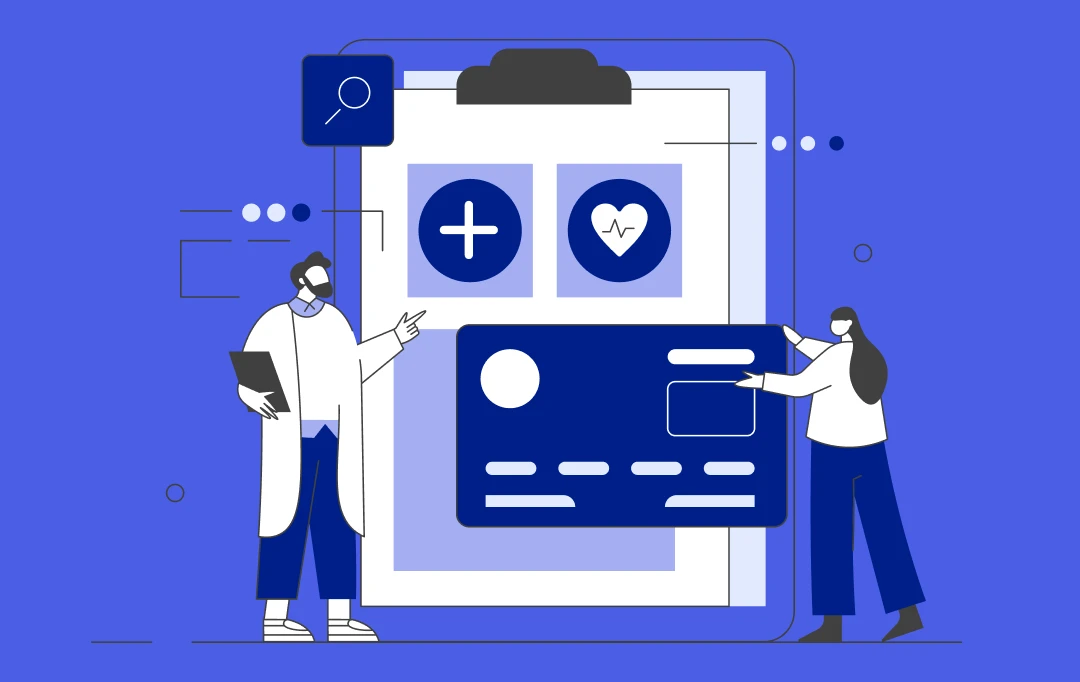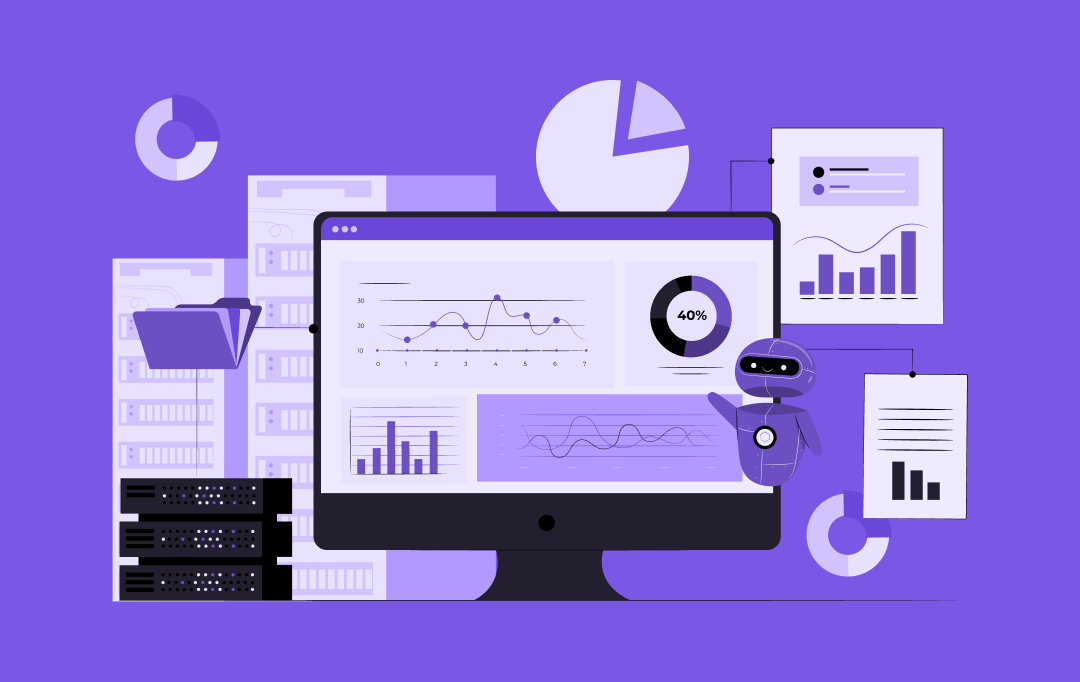- The Building Blocks of Emotion Recognition AI
- Deep Learning and Neural Networks
- Multimodal Fusion
- Vocal Biomarker Analysis
- Brain-Computer Interfaces
- Generative Emotional AI
- Affective Virtual Reality
- Natural Language Processing
- Real-Time Emotion Analytics
- Simulated Emotional Models
- Ethical Frameworks and Data Privacy Enhancements
- The Many Dimensions of Emotion Detection AI in Real-World Applications
- Marketing
- Customer Service
- Human Resources
- Healthcare
- Insurance
- Retail
- Autonomous Driving / Driver Assistance
- Gaming
- Government
- Real-World Examples of AI Emotion Recognition
- Call Center Support
- Advertising and Marketing
- Mental Health Support
- Personalized Health & Wellness
- Education
- Automotive Safety
- Retail and E-Commerce
- Healthcare
- Media and Entertainment
- FAQs
- Q. What are some prominent use cases of AI emotion recognition?
- Q. Can artificial intelligence feel emotions?
- Q. Can AI develop emotions?
- Q. What are the features of an AI emotion recognition app?
Walking into a store where a digital assistant understands your words, senses your frustration, and offers genuinely resonating solutions. This is no longer a hypothetical imagination – it’s AI emotion recognition, the frontier where technology meets human emotion.
Machines have processed data, crunched numbers, and analyzed trends for years. But they’ve lacked the emotional depth required to connect with humans truly. Artificial intelligence emotion recognition changes that narrative. Reading facial expressions, tone of voice, and text sentiment enables machines to understand and respond to human emotions in real-time.
As industries strive to stay competitive in an ever-evolving digital landscape, connecting with customers on a deeper emotional level has become more crucial. Emotional AI, with its capacity to understand, analyze, and respond to human emotions, is pivotal in enabling this shift.
Whether enhancing customer service, optimizing marketing strategies, or improving mental health support, the technology is already reshaping how businesses interact with their audiences.
In a world where personalization drives success, AI trends transform industries, helping startups and enterprises build deeper connections with their audiences. But what does this technology look like in action, and where is it making the greatest impact? Let’s explore the real-world emotion AI applications and examples shaping our future.
But to fully grasp its potential, it’s essential to understand the foundational technologies that power emotion AI applications. Let’s dive into the building blocks that make this cutting-edge innovation possible.
The Emotion AI market will skyrocket to $13.8 billion by 2032. Don’t miss the boat—stay ahead of the curve and future-proof your business.
The Building Blocks of Emotion Recognition AI
Emotional AI is powered by a convergence of cutting-edge technologies that enable machines to detect, interpret, and respond to human emotions. These foundational tools – from deep learning and natural language processing to multimodal data fusion – are designed to analyze subtle cues such as facial expressions, voice tones, and brain activity.
Together, they are transforming how technology interacts with humans, making emotion recognition AI more intuitive and emotionally aware across healthcare, marketing, and education industries.

Deep Learning and Neural Networks
Deep learning algorithms act as the engine leveraging neural networks to simulate how humans think. These systems process massive datasets, including voice recordings, images, and physiological signals, to detect patterns indicative of emotional states.
Over time, emotional AI chatbots and other solutions become more adept at interpreting nuanced expressions, such as micro-expressions or subtle changes in tone, which humans might miss. This adaptability is key in applications like mental health technology for diagnostics and personalized customer interactions.
Multimodal Fusion
Human emotions are rarely expressed through a single medium. A smile might be genuine or sarcastic, depending on vocal tone or body language. Multimodal fusion combines data from various sources – facial expressions, voice, text, and physiological responses – into a cohesive emotional profile.
By cross-referencing these inputs, artificial intelligence emotion recognition systems ensure a more accurate interpretation of complex emotional states. This approach is especially impactful in creating empathetic human-computer dialogues, particularly in healthcare and education.
Vocal Biomarker Analysis
Our voices carry emotional undercurrents that words alone can’t convey. Advanced algorithms now analyze vocal qualities like pitch, tone, speed, and volume to determine emotional states.

This is crucial for call centers, where identifying frustration or satisfaction can directly influence customer satisfaction scores. Beyond business, vocal biomarker analysis is being explored in medical fields to detect early signs of depression, anxiety, or neurological disorders.
Brain-Computer Interfaces
BCIs are revolutionizing AI-generated emotions by tapping directly into neurological signals. These systems interpret brainwave patterns associated with specific emotions, enabling highly accurate emotional detection.
Their applications extend from therapeutic interventions, such as stress management tools, to enhancing virtual reality experiences by adapting environments based on user emotions. This direct connection to the brain also allows personalized learning and enhanced gaming experiences.
Generative Emotional AI
Generative AI is evolving to create emotionally rich content, such as mood-specific music, empathetic chat responses, or emotionally intelligent narratives. These systems simulate human emotions by learning from large datasets, enabling them to produce outputs that resonate emotionally with users. Such advancements shape areas like marketing, where emotionally engaging campaigns can create stronger connections with audiences.
Affective Virtual Reality
Imagine a virtual world that responds to your emotions in real-time. VR-based emotional AI chatbot uses sensors and algorithms to gauge a user’s feelings and adapt the virtual environment accordingly. Whether creating calming scenarios for therapy or enhancing gaming experiences with emotionally responsive characters, affective VR offers a new level of immersion and personalization.
Natural Language Processing
NLP applications and use cases allow AI and emotional intelligence to understand what is said and how it is meant. These systems extract sentiment and intent by analyzing sentence structure, word choice, and context. They can flag dissatisfaction in a customer review or detect urgency in an email, making them invaluable in customer service, content moderation, and sentiment analysis for brands.
Real-Time Emotion Analytics
Real-time emotion analytics tools are designed to capture and analyze emotional responses as they occur. These systems are widely used in marketing campaigns to evaluate how audiences react to ads, in education to monitor student engagement, and in workplace settings to assess employee morale during meetings. The instantaneous feedback helps organizations adapt and optimize their strategies dynamically.
Simulated Emotional Models
These systems aim to replicate human emotional intelligence, enabling AI to “respond” authentically and empathetically. These models make interactions with machines more natural and relatable by simulating emotional states. This technology is pivotal in sectors like elder care, where AI companions are designed to provide emotional support.
Ethical Frameworks and Data Privacy Enhancements
As emotion detection AI becomes more pervasive, ensuring it adheres to ethical standards is critical. Technologies focused on reducing algorithmic bias, securing personal data, and maintaining transparency are becoming integral. These frameworks protect users and build trust, especially in sensitive industries like healthcare and finance.
These technologies collectively push the boundaries of AI-generated emotions, making machines more attuned to human emotions. From healthcare to customer service, their applications promise to redefine how humans and machines connect.
As these systems become more sophisticated, industries are discovering new ways to incorporate Emotional AI into everyday applications, creating deeper, more personalized interactions. From improving customer experiences to revolutionizing healthcare, the potential impact of AI emotion recognition continues to expand, offering exciting possibilities for the future.
The Many Dimensions of Emotion Detection AI in Real-World Applications
AI and emotional intelligence transform industries by bringing human-like intuition into decision-making processes. From enhancing customer experiences to improving healthcare outcomes, the versatility of emotional AI ensures its impact is both broad and profound. Interpreting emotions through data delivers nuanced solutions tailored to specific needs, bridging the gap between technology and human empathy. Below are some of the key emotion AI applications and examples across various industries, showcasing its transformative potential.

Marketing
The top use cases of AI emotion recognition can be seen in how the technology revolutionizes how brands interact with consumers and turns campaigns into deeply personal experiences.
Marketing Communications
Emotion AI applications identify emotional triggers through facial expressions, voice tones, and textual cues, enabling brands to craft emotionally resonant messages. For instance, AI systems analyze live reactions during product launches, allowing companies to pivot strategies in real-time. This approach creates stronger emotional connections between brands and their audiences.
Market Research
Traditional market research relies heavily on self-reported data, which can be biased or inaccurate. Emotion recognition AI overcomes this by analyzing non-verbal cues in focus groups or online surveys. For example, eye-tracking paired with emotional analytics helps gauge consumer interest in product designs or packaging, providing insights unattainable through verbal feedback alone.
Content Optimization
Platforms like Netflix or Spotify leverage Emotional AI to enhance user experience by recommending content aligned with the user’s mood. In digital advertising, AI emotion recognition use cases can dynamically modify ad formats to align with viewer sentiments, boosting engagement and conversion rates. The content can be easily optimized through content management system development.
Ad Placement
Brands merge AI and emotional intelligence to select ad placements that align with the target audience’s emotional context. For example, a wellness brand might ensure that ads appear during moments of calm and focus, maximizing relevance and impact.
Customer Service
Another one of the use cases of AI emotion recognition can be found in enabling customer service teams to address emotional cues, fostering trust and loyalty:
Intelligent Call Routing
By analyzing vocal tones and speech patterns, AI systems determine a customer’s emotional state and route them to an agent with the right expertise. This reduces friction and ensures faster problem resolution, especially for high-stress scenarios like billing disputes.
Recommendations During Calls
Artificial intelligence emotion recognition provides agents with real-time guidance during calls. For example, if a customer displays frustration, the system may suggest offering a discount or escalating the issue to a manager. These actionable insights create more positive outcomes.
Customer-Agent Matching
Emotion AI applications and examples are often applied to align customers with agents who have complementary skills or temperaments. For instance, empathetic agents might handle emotionally charged situations, while analytical agents may assist with technical issues, enhancing overall satisfaction.
Churn Prediction
AI detects subtle signs of dissatisfaction in interactions, such as pauses, negative sentiment, or abrupt tone changes. Companies can act preemptively by offering personalized solutions, reducing customer churn.
Human Resources
AI emotion recognition is a game-changer for employee management, ensuring productivity and well-being:
Recruitment
Undoubtedly, AI is revolutionizing talent hiring. Video interviews powered by artificial intelligence emotion recognition assess candidates’ body language, speech patterns, and emotional responses to determine suitability beyond resumes. This helps companies identify candidates with strong emotional intelligence and cultural alignment, improving hiring success rates.
Employee Training
Personalized training modules adapt in real-time based on emotional feedback, such as frustration or boredom. For instance, interactive simulations in leadership training can dynamically adjust difficulty levels based on stress indicators, keeping employees engaged and motivated.
Tracking Team Member Satisfaction
One of the benefits of AI emotion recognition can be seen through the technology analyzing internal communications, employee surveys, and even meeting dynamics to assess morale and identify potential burnout risks. HR teams can use these insights to implement timely interventions, boosting team cohesion and overall workplace satisfaction.
Healthcare
In healthcare, AI emotion recognition bridges the gap between clinical care and emotional well-being:
Patient Care
Artificial intelligence emotion recognition monitors patients’ emotional states in real-time, providing valuable insights for personalized care plans. In elder care, AI-powered systems can detect signs of distress or loneliness, alerting caregivers to take immediate action.
Counseling
Virtual counseling platforms equipped with the benefits of AI emotion recognition can assess vocal tones and facial cues to gauge patient emotions, enabling therapists to tailor their responses. This particularly benefits remote mental health services, where non-verbal communication is crucial.
Mental Health Monitoring
Mental health technologies have made mental health monitoring quick and easy.

Emotional AI applications like Woebot or Replika detect early signs of depression or anxiety through daily interactions, empowering users to seek help before conditions worsen.
Disaster and Emergency Management
Solutions like the SONAR use Emotional AI to evaluate population-wide emotional responses during crises. This helps authorities allocate resources efficiently and provide targeted support.
Blood Pressure Detection
The American Heart Association, in collaboration with NuraLogix, developed an app using emotion-sensing algorithms to detect blood pressure levels from short video clips. This innovation promises non-invasive monitoring and early intervention for hypertension.
Insurance
The impact of AI emotion recognition, especially in the insurance space, can be seen in the technology mitigating risks and improving customer interactions and trust.
Financial Fraud Detection
AI and ML help detect financial fraud. Emotional AI detects fraudulent claims by analyzing inconsistencies in emotional cues like facial expressions or speech patterns during interviews, reducing economic losses.
Underwriting
Emotional AI evaluates customers’ risk profiles by analyzing application stress levels and behavioral patterns, enabling insurers to make more precise underwriting decisions.
Customer Retention
By gauging customer emotions during service calls or complaints, insurers can proactively address dissatisfaction and offer personalized solutions, increasing loyalty.
Disaster Management
Emotional AI monitors public sentiments after disasters, helping insurers prioritize claims and deploy resources effectively to assist affected customers.
Retail
Retailers use Emotional AI to create personalized and engaging shopping experiences:
In-Store Shopping Experience
Cameras equipped with Emotional AI detect customers’ emotions, enabling staff to provide tailored assistance. For instance, a frustrated customer might be offered quick check-out solutions.
Read Also: How AI in Retail Improves Shopping Experiences
Online Personalization
When incorporated through an emotional AI chatbot, the technology can track browsing behaviors, such as hesitation before purchasing, to deliver targeted discounts or recommendations, reducing cart abandonment.
Customer Feedback Analysis
AI analyzes tone and sentiment in reviews or feedback forms to pinpoint pain points in the shopping experience, helping retailers refine their strategies.
Demand Prediction
By tracking emotional trends in customer reactions, retailers can predict demand for specific products and optimize inventory accordingly.
Autonomous Driving / Driver Assistance
Emotional AI makes driving safer and more adaptive:
Safety
Systems monitor fatigue or emotional distress in drivers, issuing alerts or taking control to prevent accidents. For instance, Hyundai’s “Emotional Driving” system adjusts cabin settings based on driver emotions.
Driving Performance
AI adjusts car features like music, temperature, or navigation instructions based on the driver’s emotional state, creating a more comfortable driving experience.
Road Rage Detection
Emotional AI identifies aggressive behavior in drivers, offering calming interventions like soothing music or even limiting vehicle speed.
Passenger Experience
Ride-sharing platforms use Emotional AI to assess passengers’ emotional states and optimize in-car features like lighting or music to enhance comfort.
Gaming
AI has already taken the gaming industry to a whole new level. Emotional AI can elevate gaming by making it more immersive and adaptive.
Testing
AI analyzes emotional responses during game development to refine characters, storylines, and challenges, ensuring an engaging final product.
Adaptive Games
Games adapt difficulty levels, visuals, or soundtracks based on the player’s emotional state, enhancing engagement and enjoyment.
Virtual Reality
Emotional AI in VR gaming creates lifelike NPCs (non-playable characters) that respond to player emotions, making gameplay more realistic and interactive.
Esports Coaching
Emotional AI in sports helps professional gamers analyze their stress or excitement levels and suggest strategies to improve performance.
Government
Governments can leverage Emotional AI to improve public communication and policy-making.
Understanding the General Mood of the Population
Sentiment analysis tools track public emotions on social media during crises or political campaigns, guiding policy adjustments and communication strategies.
Tracking Citizen Reactions
AI systems monitor public sentiment towards new policies or infrastructure projects, proactively providing insights to address concerns.
Emergency Response
Emotional AI assesses population-wide emotional states during disasters, helping prioritize aid and prevent panic through effective communication.
Community Engagement
AI enhances civic engagement by analyzing emotions in surveys or town hall meetings, enabling governments to address citizen concerns effectively.
From heartfelt customer interactions to personalized experiences, our bespoke AI services turn algorithms into connections and supercharge your AI with emotions.
As Emotional AI continues to reshape industries, its real-world applications are growing in scope and impact. At Appinventiv, we build products that leverage Emotional AI to help businesses create more personalized, empathetic, and engaging experiences for their audiences. By integrating this advanced technology, we empower companies to connect with users on a deeper emotional level, improving customer satisfaction and driving innovation.
Let’s look at how Emotional AI is applied across various sectors, highlighting its potential to transform everything from healthcare to marketing.
Real-World Examples of AI Emotion Recognition
Emotional AI is revolutionizing various sectors by offering real-time insights into human emotions, improving customer service, enhancing engagement, and optimizing experiences. Below are some examples of emotional AI technology being applied in real-world scenarios.

Call Center Support
Emotional AI is enhancing customer service by providing real-time emotional insights during calls. For instance, Cogito uses AI to monitor voice signals and give the agents instant feedback on customer sentiment. This technology helps agents adjust their tone or approach based on emotional cues, improving customer satisfaction and reducing churn.
Advertising and Marketing
Emotional AI is revolutionizing marketing by measuring emotional reactions to content. Realeyes, for example, utilizes webcams to track facial expressions during ad engagement, allowing brands to refine their content based on emotional responses. Similarly, iMotions offers advanced biometric and facial coding tools to help marketers optimize campaigns by identifying emotional triggers that resonate with target audiences.
Mental Health Support
Emotional AI is making strides in mental health applications. Woebot, a therapy-based emotional AI chatbot, uses NLP and emotional intelligence to support users with mental health challenges. Leveraging techniques like cognitive behavioral therapy (CBT) provides personalized, empathetic interactions that help users navigate their emotions. Moreover, Ellie, developed by the National Center for Biomedical Computing, uses AI to assess emotional states through facial expressions, voice tone, and speech patterns, assisting clinicians in diagnosing and monitoring mental health conditions.
Personalized Health & Wellness
Emotion AI has the potential to tailor health and wellness solutions, understanding and responding to human emotional states in different ways. It is one of the critical ways Emotion AI will be pivotal in tracking personal health in real-time. Emotion AI can easily do voice sentimental analysis, facial recognition, and text analysis for better interventions.
For example, Appinventiv developed a personalized health & wellness app called Soniphi. The app works on speech recognition and Emotion AI systems.

The recorded audio mechanism in the app deploys 94% of the user’s vocal information, and emotional AI analyzes and understands the voice sentiments through different emotion modalities and provides a complete well-being analysis report on the personal healthcare app.
Education
Examples of emotional AI can be seen in improving learning experiences by gauging student engagement and emotions. Entropik analyzes facial expressions, eye movements, and biometric data to optimize online tutoring by adjusting content delivery to emotional states like boredom or confusion.
Additionally, Cogito collaborates with educational institutions to assess emotional engagement during lectures, providing insights to improve lesson plans and student participation.
Automotive Safety
Emotional AI in the automotive industry focuses on enhancing safety by monitoring driver emotions. Affectiva, a pioneer in this field, integrates AI in vehicles to detect signs of driver fatigue or distraction through facial expression and vocal tone analysis. This data is used to alert the driver or adjust vehicle settings for enhanced safety. Additionally, Nauto, a driving assistant system, uses AI to assess emotional and physical states to reduce accidents by intervening when drivers are distracted, stressed, or fatigued.
Retail and E-Commerce
Emotional AI also transforms the retail experience by tailoring interactions based on customer emotions. Klingel uses emotion detection to personalize customer product recommendations by analyzing facial expressions and voice tones during live shopping sessions. Similarly, CureMetrix leverages emotional AI in the medical industry to improve diagnostic accuracy by detecting emotions linked to patient concerns during consultations.
Healthcare
Emotional AI in healthcare is advancing patient care by offering real-time emotion-based analysis. NuraLogix’s AI technology, for example, uses video-based emotion detection to measure blood pressure levels. The American Heart Association has leveraged this technology in a mobile app that analyzes a person’s facial expressions to estimate blood pressure, providing a non-invasive, easy-to-use tool for healthcare providers.
Media and Entertainment
Companies like Disney are using emotional AI to optimize movie production. By tracking emotional responses to scenes through facial coding and biometric sensors, Disney ensures that films evoke the desired emotions from audiences, leading to a stronger connection and better reception. IBM Watson also uses emotional AI to enhance viewer experiences by analyzing emotional reactions to films and television shows and adjusting content accordingly.
These real-world applications demonstrate how emotional AI is a key enabler across multiple industries, from improving customer experience to enhancing safety, education, and mental health. Businesses leveraging these innovations gain a competitive edge by offering more personalized, empathetic, and effective interactions with customers, employees, and patients.
Emotional AI is more than a technological advancement; it’s a game-changer helping businesses build stronger connections with their audiences.
From enhancing customer service interactions to improving mental health support, the potential of this technology is vast. As we’ve seen through the real-world emotion AI applications and examples across industries, the impact is already being felt, and it’s only just beginning to scratch the surface.
At Appinventiv, we’re proud to be part of emerging emotion AI applications and examples revolution as an AI development company building cutting-edge products that elevate user experiences and foster deeper engagement.
As the technology evolves, its applications will continue transforming industries, creating a future where businesses and customers connect more meaningfully. The future of Emotional AI is bright, and we are excited to continue pushing the boundaries of what’s possible. Contact us to deploy Emotion AI in your business and unlock personalized customer experiences while driving meaningful engagement.
FAQs
Q. What are some prominent use cases of AI emotion recognition?
A. AI in emotion recognition is being used in various industries such as:
Customer Service: Enhancing customer interactions by analyzing emotions in voice and text, enabling personalized responses.
Marketing: Evaluating emotional reactions to advertisements and content, helping brands optimize campaigns for better engagement.
Healthcare: Monitoring patients’ emotional well-being, especially in mental health care, by analyzing facial expressions and voice patterns.
Automotive: Enhancing safety by detecting driver emotions (e.g., fatigue or stress) and adjusting vehicle functions accordingly.
Q. Can artificial intelligence feel emotions?
A. No, AI cannot feel emotions. It can only simulate or recognize emotional states by analyzing data such as voice tone or facial expressions. However, it does not have subjective emotional experiences like humans.
Q. Can AI develop emotions?
A. No, AI cannot develop emotions. It can recognize and respond to emotional signals but does not experience emotions. Its reactions are based on programmed algorithms and data-driven predictions, not emotional awareness.
Q. What are the features of an AI emotion recognition app?
A. An AI emotion recognition app typically includes:
Facial Expression Analysis: Identifying emotions through facial movements.
Voice Tone Analysis: Detecting emotional cues from speech.
Sentiment Analysis: Assessing emotions from text input.
Real-Time Feedback: Providing instant emotional insights during interactions.
These features enable the app to interpret and respond to user emotions effectively.



How Much Does It Cost to Build an App like Janitor AI?
Key takeaways: Cost Breakdown: The cost of app development varies, with an MVP App costing $40,000 to $90,000, a Mid-Tier App costing $100,000 to $200,000, and an Enterprise Grade App costing $300,000 to $ 500,000 or more, depending on features, complexity, and the expertise of the development team. Key Factors: Platform choice, AI integration, and…

10 Ways AI is Transforming the Healthcare Sector in Australia
Key takeaways: Generative AI could add $13 billion annually to Australia’s healthcare sector by 2030. AI is already transforming operations across diagnostics, admin tasks, and patient care. Healthcare in remote areas is improving with AI-powered virtual assistants and monitoring tools. AI can help address workforce shortages by automating routine tasks and supporting clinical decisions. Major…

Exploring the Power of AI in Creating Dynamic & Interactive Data Visualizations
Key takeaways: AI transforms data visualization by providing automated insights, interactive dashboards, and NLP, thereby tackling revenue loss and improving data quality. Key features include predictive analytics, real-time data integration, and user-friendly visualizations, enabling faster and more informed decisions. Top 2025 tools, such as Tableau, Power BI, and Julius AI, offer NLP and real-time analytics…

















